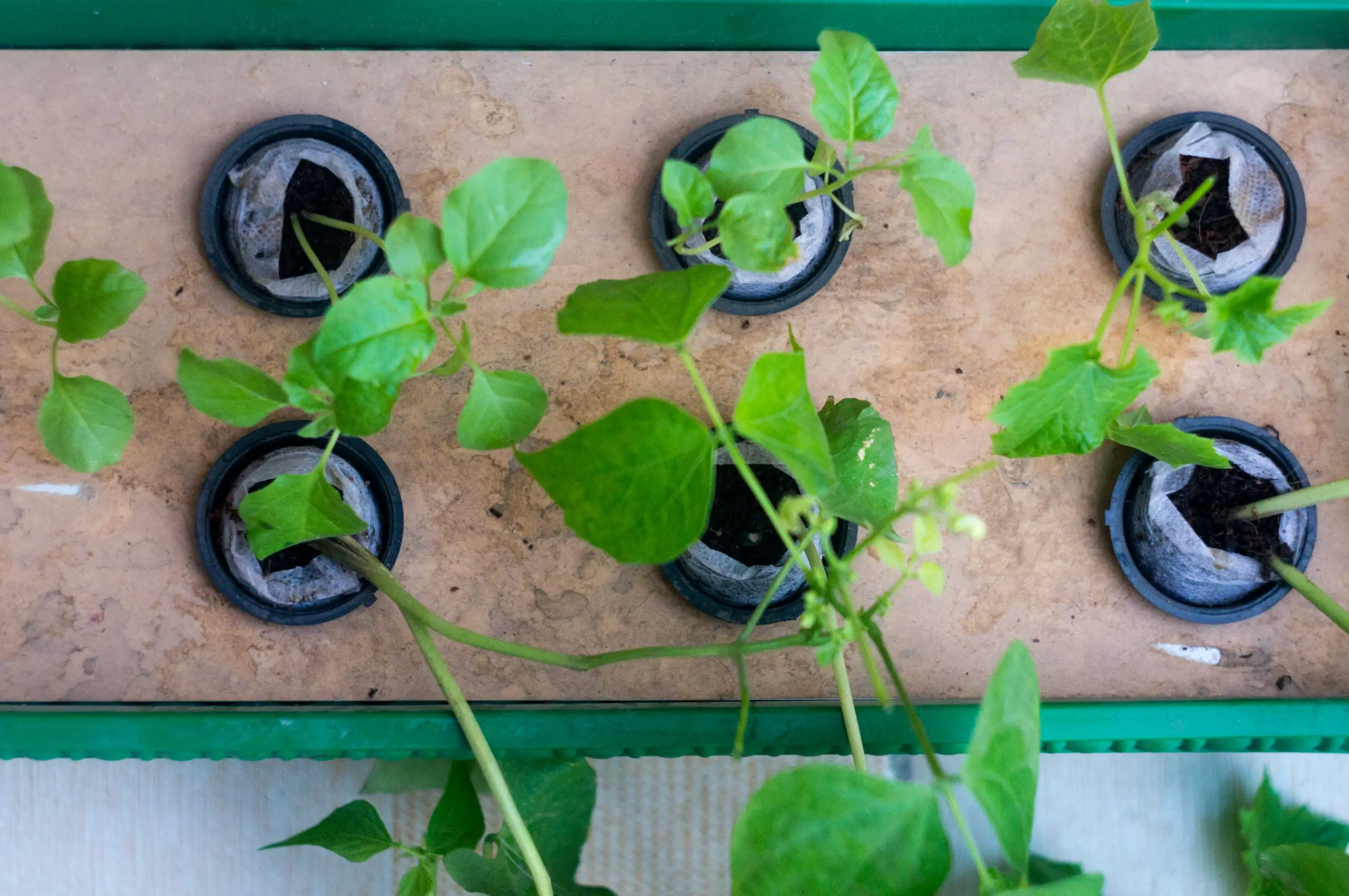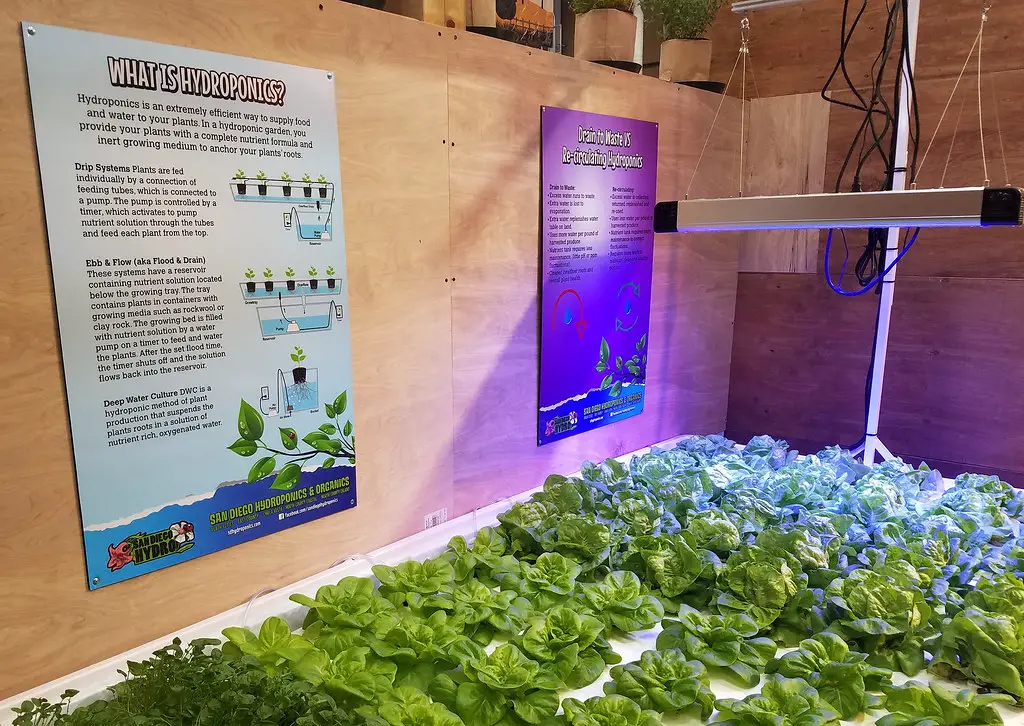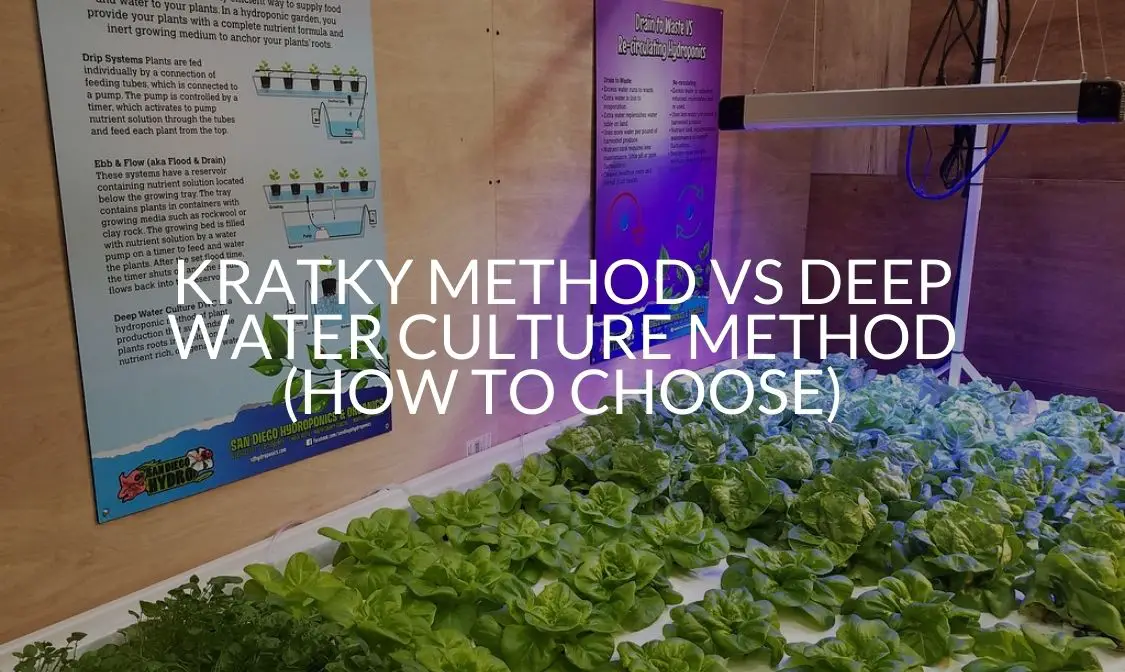The Kratky Method and Deep Water Culture method are considered great growing systems for beginners, hobbyists, and small-scale commercial operations alike. While the Kratky Method offers slightly less in setup costs and maintenance, the Deep Water Culture system allows for an increased variety of what you can grow as well as being more scaleable.
This article will look at how each system works, the pros and cons of both, and how to decide which is the best method for you.
How Does The Kratky Method Work
The Kratky method is a self-contained, passive hydroponics system that, once correctly set up, needs no further maintenance from you.
Fill your reservoir with conditioned water ensuring that the lower third of the net pot is submerged in the water. This is important because, minus an airstone, your plants will need water from the very beginning to grow. Setting them in the nutrient reservoir will ensure they will never dry out.
As your plant grows, it will consume the water and cause the water level to decline. The roots will have grown into the nutrient solution by the time this happens.
The roots left in the air gap that develops are called air roots. This is what makes the Kratky system so unique. This air gap contains the oxygen that the roots need in order to help the plant survive and grow. Essentially, it has created its own aeration system known as “Air Roots.”
A Brief Guide To Setting up The Kratky Method
What You’ll Need
- 5-gallon bucket with lid
- Net pot
- Uncontaminated water
- Control kit ; pH kit
- Hydroponic units
- Growing medium
Build Your Reservoir
Cut a hole in the lid that matches the size of your net pot.
Add Water And Nutrients
Fill the bucket with uncontaminated water to three inches from the top. Add hydroponic nutrients per instructions on the package.
Check pH
Using your testing kit, check the 5-gallon pH level; aim to be between 5.5 and 6.5.
Inserting The Plant
Start seed or a small plant in the grow medium in the net pot. Once it starts to grow, insert the net pot into the hole in the bucket lid. A third of the net pot should be submerged in the water.
Time To Grow
As your plant grows, its roots will grow down in the water as the water level is decreased by the plant. Keep your plant somewhere warm (room temp) with access to sunlight.
What Are The Best Plants to Grow With The Kratky Method?
Though not exhaustive, you will see good results with these plants using the Kratky Method.
- Lettuce
- Spinach
- Basil
- Kale
- Tomato
- Chive
- Peppers
- Coriander
- Strawberries
- Mint

What Are The Pros And Cons Of The Kratky Method?
The Kratky method is an excellent way for beginners to get started growing their plants using hydroponics.
Pros
- Energy-efficient: This method requires no electrical source in which to grow your plants. This is great for growers on a budget or who are off the grid, not to mention placement of your plants is not restricted to where there is electrical access.
- Simplicity: The simplicity of setup makes this a great choice for beginner hydroponic gardeners.
- Less time involvement: After setup, there is minimal to no maintenance. This is great for the gardener that doesn’t have as much time to invest in maintenance that other hydroponic systems may require.
- Less cost: Fewer equipment requirements equals less expense for you.
Cons
- Limitations on what you can grow: Not every plant can be grown with the Kratky method. Generally, leafy green plants with shorter growing periods, around 45 days, works best with this method.
- Pests: Stagnant water can be an attraction for unwanted insects.
- Small scale only: Each plant requires its own reservoir, which can be cumbersome. If your interest is to grow greater numbers of plants, this method may not be for you.
How Does A Deep Water Culture Work (DWC)?
True to its name, the Deep Water Culture works by continually submerging the plant roots in a lot of water. A relatively simple hydroponic system, the key to making a Deep Water Culture system work is keeping the water well-oxygenated.
Starting with your reservoir, you will need to fill it with nutrient-rich water. You must then have an air pump and air stone that will be connected by an airline.
The air pump pumps air into the airstone, then diffuses the air into the water. This effectively keeps the water well oxygenated, which is crucial to prevent the plants from drowning.
The young plants are placed in net pots suspended above the water, allowing them to develop a robust root system. Once the roots reach the nutrient-rich water, the plants will experience an explosion in growth.
A Brief Guide To Setting Up A Deep Water Culture System
What You’ll Need
- 5-gallon bucket
- Air pump
- Airstone
- Tubing
- pH control kit
- PPM meter
- Growing media
- Hydroponic nutrients
- Net pot
- Plants
Germinate Seeds
Put your starter seeds in a net pot to germinate.
Build Your 5-Gallon Reservoir
Cut a hole in the top of the bucket to accommodate the net pot.
Add Water And Nutrients
Fill the bucket two-thirds full with uncontaminated water. Add hydroponic nutrients per instructions on the package.
Setup Air Pump
Place the airstone in the bottom of your bucket. Setup air pump nearby. Attach the air pump and airstone together with the air tubing. Make sure to use black, opaque tubing to ensure that there is no algae growth in the tube.
Inserting The Plant
Once your seed has germinated, place the net pot into the bucket through the hole in the lid, make sure the air pump is on and working.
Time To Grow
Once the roots of your plant reach the water, your plant should experience accelerated growth. Remember to set it in a warm, room temperature environment with plenty of access to sunlight to help it grow.
What Are The Best Plants to Grow With The Kratky Method?
Though not exhaustive, you will see good results with these plants using the Kratky Method.
- Lettuce
- Spinach
- Basil
- Kale
- Okra
- Collard greens
- Sorrel
- Coriander
- Chard

The Pros And Cons Of A Deep Water Culture System
Pros
- Easy starter system: This is a popular hydroponic system because it is easy and inexpensive to set up. It makes a great method for beginners or those who want to keep things uncomplicated.
- Low maintenance: Relatively low maintenance once you get it set up.
- Fast grow times: Accelerated growth and larger yields.
- Large range of plants: This method successful with a large variety of plants and even trees.
- Large DWC system: pH levels and water temperature do not fluctuate as much.
Cons
- Requires electricity: Will need to have enough electrical power, which could become more expensive in larger-scale operations. A power failure could have adverse effects on plants.
- Can’t sprout seeds directly: Need to transplant germinated seeds into a DWC system.
- Small DWC system: pH levels, nutrients, temperature more prone to fluctuate.
- Plant types limited: Although this type of grow system is suitable for a range of leafy, green plants and herbs, it can become top-heavy and cause the raft to tip.
- Disease transmission: Because plants are contained in the same system, one plant may transmit a disease to the others in the same system.
- Increased setup costs: Special equipment needed.
How To Choose The Right Hydroponic System?
Consider the following factors when deciding which hydroponic system is best for you.
- Time availability
- Lighting
- Available finance
- Space availability
- Type of crop
- Will you want to expand
When Should You Use The Kratky Method?
The Kratky Method is a great place for beginners to start. Generally less work with fewer things that can go wrong, this passive system is self-contained, making it a low-maintenance start for someone who is just learning.
Those that don’t have a lot of extra money or space will find this method well adapted to their needs.
What Do You Want To Grow?
The Kratky Method works best with faster-growing, leafy green plants like lettuce and spinach. You can grow some things like tomatoes, but they consume tremendous amounts of water and will take more careful monitoring to make sure the water levels remain optimal.
This speedy turnaround time on growth will also increase productivity and profit for smaller growth operations.
What Scale Is Your Growing Operation?
The Kratky methods typically work best for more minor growing needs and operations. So you will want to consider several factors.
Is this just for yourself and your family? If you are growing extra food to supplement mealtime and save on the grocery bill, the Kratky Method is a great, low investment option.
Do you want to grow commercially? If you are considering growing commercially, what scale are you thinking of? If you’re going to sell some extra produce for your local farmer’s market during the summers, this could still be a viable option.
If your ambitions are grander, the Kratky method becomes less scaleable. Not only does it become less efficient the larger the scale, but it can also become harder to maintain correct pH levels, temperatures, and nutrients.
Say, for example, you start with a large quantity nutrient solution that is used in multiple reservoirs, but your pH was off from the beginning. As time goes on, each individual reservoir will need more intensive monitoring and work to course-correct because your source nutrient solution was wrong.
Electricity Concerns
If you are working in a greenhouse with no electrical outlets, the Kratky Method will undoubtedly be the best choice. Smaller commercial operations will also benefit from this method by not having the increased costs of electricity bills or the concerns over losing crops because of a power outage.
Time Investment
If you want to grow your own food or do so on a smaller commercial scale but don’t have much extra time, then the Kratky Method is the right choice because maintenance will be minimal after your initial setup.
When Should You Use Deep Water Culture?
The DWC system is also a good starter system for those new to hydroponics or a great next step for those ready to graduate from the Kratky Method.
What Do You Want To Grow?
Deciding what to grow in a DWC system should take into account personal taste, local market demands, and the physical requirements of the plants.
You will want to consider lightweight plants like lettuce, herbs, spinach, etc. Heavy plants may eventually cause the raft to tip over because the roots are not anchored in the soil.
DWC is a horizontal growth system which means that you can’t go vertical. So you will want to consider plants that don’t require a lot of space between them in order to maximize crop volume.
Don’t choose plants that like it dry, such as rosemary. They will not thrive.
What Scale Is Your Growing Operation?
DWC is a great method for small commercial operations that have sufficient access to reliable electricity as well as the horizontal space to spread out.
Compared to other hydroponic systems, DWC is considered to be less time-consuming. There will be more maintenance than the Kratky Method because you will need to replace the nutrient reservoir about once a month.
Cost
Your electrical bill will notice an increase with DWC. There will also be increased setup costs to purchase air pumps and more.
Time Investment
Compared to other hydroponic systems, DWC is considered to be less time-consuming. There will be more maintenance than the Kratky Method because you will need to replace the nutrient reservoir about once a month.
Final thoughts
Both the Kratky Method and Deep Water Culture Method are relatively easy to set up and maintain for all skill levels in hydroponics. When deciding between either method, your primary considerations will be time, cost, space, and what type of plant works best for each method.
Either way, this is an exciting hobby that more and more people are trying out. Enjoy your journey in learning how to be a hydroponic gardener!




